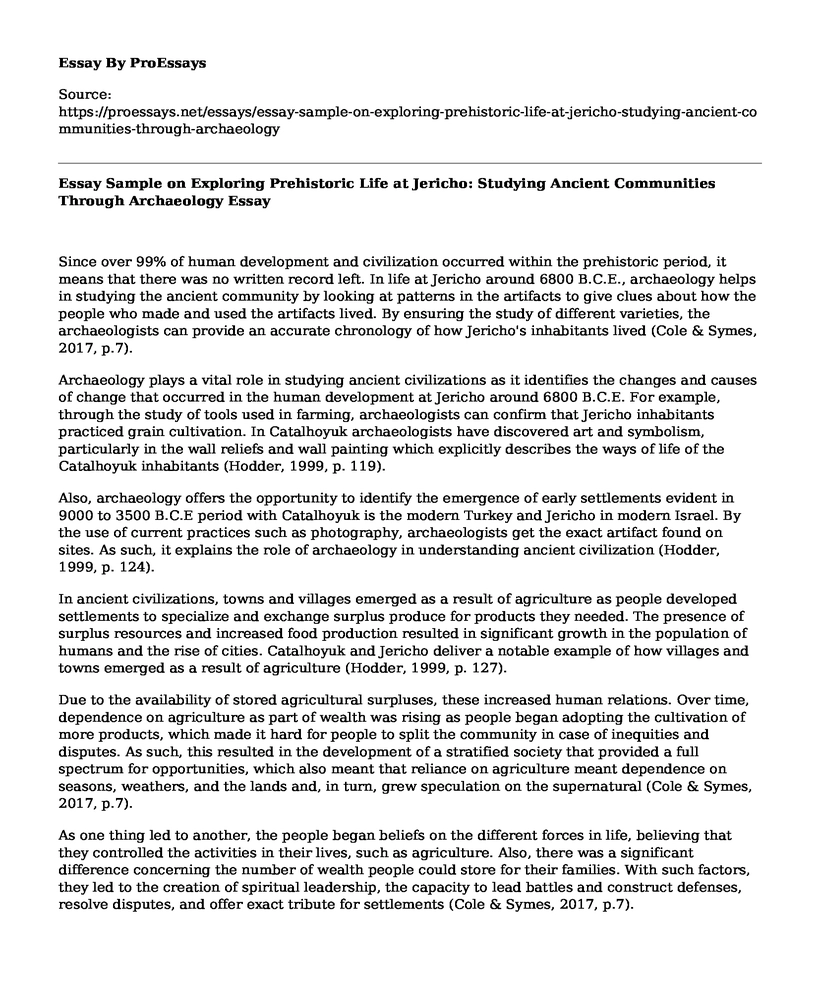Since over 99% of human development and civilization occurred within the prehistoric period, it means that there was no written record left. In life at Jericho around 6800 B.C.E., archaeology helps in studying the ancient community by looking at patterns in the artifacts to give clues about how the people who made and used the artifacts lived. By ensuring the study of different varieties, the archaeologists can provide an accurate chronology of how Jericho's inhabitants lived (Cole & Symes, 2017, p.7).
Archaeology plays a vital role in studying ancient civilizations as it identifies the changes and causes of change that occurred in the human development at Jericho around 6800 B.C.E. For example, through the study of tools used in farming, archaeologists can confirm that Jericho inhabitants practiced grain cultivation. In Catalhoyuk archaeologists have discovered art and symbolism, particularly in the wall reliefs and wall painting which explicitly describes the ways of life of the Catalhoyuk inhabitants (Hodder, 1999, p. 119).
Also, archaeology offers the opportunity to identify the emergence of early settlements evident in 9000 to 3500 B.C.E period with Catalhoyuk is the modern Turkey and Jericho in modern Israel. By the use of current practices such as photography, archaeologists get the exact artifact found on sites. As such, it explains the role of archaeology in understanding ancient civilization (Hodder, 1999, p. 124).
In ancient civilizations, towns and villages emerged as a result of agriculture as people developed settlements to specialize and exchange surplus produce for products they needed. The presence of surplus resources and increased food production resulted in significant growth in the population of humans and the rise of cities. Catalhoyuk and Jericho deliver a notable example of how villages and towns emerged as a result of agriculture (Hodder, 1999, p. 127).
Due to the availability of stored agricultural surpluses, these increased human relations. Over time, dependence on agriculture as part of wealth was rising as people began adopting the cultivation of more products, which made it hard for people to split the community in case of inequities and disputes. As such, this resulted in the development of a stratified society that provided a full spectrum for opportunities, which also meant that reliance on agriculture meant dependence on seasons, weathers, and the lands and, in turn, grew speculation on the supernatural (Cole & Symes, 2017, p.7).
As one thing led to another, the people began beliefs on the different forces in life, believing that they controlled the activities in their lives, such as agriculture. Also, there was a significant difference concerning the number of wealth people could store for their families. With such factors, they led to the creation of spiritual leadership, the capacity to lead battles and construct defenses, resolve disputes, and offer exact tribute for settlements (Cole & Symes, 2017, p.7).
Furthermore, villages and towns emerged in ancient civilization as a result of trade. At around 9000 B.C.E local tradings were growing within the local settlements, whereas by 5000 B.C.E., long-distance routes linked settlements in different regions. Boosted by agricultural surplus, the long-distance trade expanded specialization, which accelerated the exchange of information and equally increased social stratification (Cole & Symes, 2017, p.7).
The creation of different social status helped in access of goods while the local elites attempted to monopolize trade through organization into small settlements. Because of the increased specialization in activities such as making tools, pottery, cloth, fortification, and also facilitation of trade, this resulted in artistic, political, and intellectual quests. With this, civilization into the modern has been created (Cole & Symes, 2017, p.7).
References
Cole, J., & Symes, C. L. (2017). Western Civilizations: Their History & their culture. WW Norton & Company.
Hodder, I. (1999). The Archaeological Process: An Introduction. Oxford: Blackwell. (118-127).
Cite this page
Essay Sample on Exploring Prehistoric Life at Jericho: Studying Ancient Communities Through Archaeology. (2023, Mar 27). Retrieved from https://proessays.net/essays/essay-sample-on-exploring-prehistoric-life-at-jericho-studying-ancient-communities-through-archaeology
If you are the original author of this essay and no longer wish to have it published on the ProEssays website, please click below to request its removal:
- Why Culture Is Important to Understanding Communication? - Essay Sample
- Ex-convict's Re-Entry Into the Society Essay
- Aristotle Friendship Essay Example
- Ethnic Residential Concentration in the Suburb of Cabramatta Essay
- Personal Identity and Communication Essay Example
- Essay Sample on Social Media: Connecting Digital Worlds and Cheating Lives
- Challenges of Bias in IQ Tests and Strategies for Addressing Worldview Conflicts in Professional Settings







